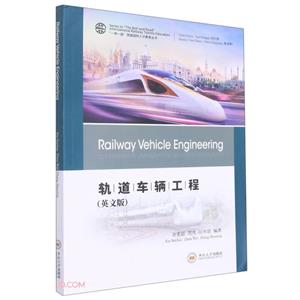中圖網小程序
一鍵登錄
更方便
本類五星書更多>
-
>
公路車寶典(ZINN的公路車維修與保養秘籍)
-
>
晶體管電路設計(下)
-
>
基于個性化設計策略的智能交通系統關鍵技術
-
>
花樣百出:貴州少數民族圖案填色
-
>
山東教育出版社有限公司技術轉移與技術創新歷史叢書中國高等技術教育的蘇化(1949—1961)以北京地區為中心
-
>
鐵路機車概要.交流傳動內燃.電力機車
-
>
利維坦的道德困境:早期現代政治哲學的問題與脈絡
軌道車輛工程(英文版) 版權信息
- ISBN:9787548748083
- 條形碼:9787548748083 ; 978-7-5487-4808-3
- 裝幀:一般膠版紙
- 冊數:暫無
- 重量:暫無
- 所屬分類:>>
軌道車輛工程(英文版) 內容簡介
本書主要講述我國鐵路常見的、有代表性的主型軌道車輛的構造、作用、原理、總體設計、車輛強度和動力學的基本原理。主要內容包括: 軌道車輛基本知識、轉向架結構原理及基本部件、車端連接裝置、車輛車體、車輛的運行性能、車輛結構強度、車輛總體設計等。本書作為該領域的英語參考書, 介紹了該領域的關鍵技術、研究成果和前沿動態。
軌道車輛工程(英文版) 目錄
Chapter 1 Basic Knowledge of Railway Vehicles
1.1 Characteristics and composition of railway vehicles
1.2 Use and classification of railway vehicles
1.3 Coding, marking and positioning of railway vehicles
1.4 Railway limits
1.5 Main technical parameters of railway vehicles
1.6 Summary of railway line structure
Thinking and reviewinging questions
Chapter 2 Structure, Principle and Basic Composition of Bogies
2.1 Structure, principle and basic composition of bogies
2.2 Classification of bogies
2.3 Wheelset
2.4 Journal box
2.5 Elastic suspension device
2.6 Damping device
Thinking and reviewing questions
Chapter 3 Bogies on Freight Vehicles
3.1 Development of China's freight vehicle bogies
3.2 8A-series bogies
3.3 K1, K2 and K6-bogie
3.4 K4 and K5-bogie
3.5 K3 and Y25-bogie
3.6 Freight car radial bogies
3.7 Freight car fast bogies
3.8 Freight car multi-axle bogies
Thinking and reviewing questions
Chapter 4 Bogie of Passenger Railcar
4.1 Role of passenger railcar bogie
4.2 Development of China's passenger vehicle bogies
4.3 Bogie type
4.4 Passenger vehicle bogie of 209 T-type
4.5 Passenger vehicle bogie of 206-type
4.6 Passenger vehicle bogie of a quasi-high-speed train
4.7 Other types of passenger vehicle bogies
Thinking and reviewing questions
Chapter 5 Running Performance of Railway Vehicles
5.1 Causes of vehicle vibration
5.2 Vibration on a sprung mass system
5.3 Vibration of a vehicle system
5.4 Vehicle running performance evaluation and standards
Thinking and reviewing questions
Chapter 6 Coupler and Draft Gear
6.1 Composition, installation and opening of coupler buffer devices
6.2 The type, working principle and material of the coupler
6.3 Buffer performance index and common types of buffers
6.4 Relationship between coupler force and buffer performance
6.5 Development of coupler buffers at home and abroad
Thinking and reviewing questions
Chapter 7 Passenger Vehicle Body
7.1 Types of passenger vehicle
7.2 Body structure of 25-type passenger vehicle
7.3 Body structure of double-deck passenger vehicle
7.4 Body structure of urban rail vehicle
7.5 Body structure of electric multiple units (EMU)
Thinking and reviewing questions
Chapter 8 Vehicle Structural Strength
8.1 Load on the vehicle
8.2 Load on the vehicle body or bodies
8.3 Load on the bogie
8.4 Vehicle strength analysis
8.5 Vehicle component strength test
Thinking and reviewing questions
Chapter 9 Design of Vehicle
9.1 Overall design of vehicle
9.2 Selection of technical and economic indicators
9.3 Lightweight and anti-corrosion design of vehicle
9.4 Ergonomic design of vehicle
9.5 Overall size design of vehicle
9.6 Overall design of bogie
Thinking and reviewing questions
References
1.1 Characteristics and composition of railway vehicles
1.2 Use and classification of railway vehicles
1.3 Coding, marking and positioning of railway vehicles
1.4 Railway limits
1.5 Main technical parameters of railway vehicles
1.6 Summary of railway line structure
Thinking and reviewinging questions
Chapter 2 Structure, Principle and Basic Composition of Bogies
2.1 Structure, principle and basic composition of bogies
2.2 Classification of bogies
2.3 Wheelset
2.4 Journal box
2.5 Elastic suspension device
2.6 Damping device
Thinking and reviewing questions
Chapter 3 Bogies on Freight Vehicles
3.1 Development of China's freight vehicle bogies
3.2 8A-series bogies
3.3 K1, K2 and K6-bogie
3.4 K4 and K5-bogie
3.5 K3 and Y25-bogie
3.6 Freight car radial bogies
3.7 Freight car fast bogies
3.8 Freight car multi-axle bogies
Thinking and reviewing questions
Chapter 4 Bogie of Passenger Railcar
4.1 Role of passenger railcar bogie
4.2 Development of China's passenger vehicle bogies
4.3 Bogie type
4.4 Passenger vehicle bogie of 209 T-type
4.5 Passenger vehicle bogie of 206-type
4.6 Passenger vehicle bogie of a quasi-high-speed train
4.7 Other types of passenger vehicle bogies
Thinking and reviewing questions
Chapter 5 Running Performance of Railway Vehicles
5.1 Causes of vehicle vibration
5.2 Vibration on a sprung mass system
5.3 Vibration of a vehicle system
5.4 Vehicle running performance evaluation and standards
Thinking and reviewing questions
Chapter 6 Coupler and Draft Gear
6.1 Composition, installation and opening of coupler buffer devices
6.2 The type, working principle and material of the coupler
6.3 Buffer performance index and common types of buffers
6.4 Relationship between coupler force and buffer performance
6.5 Development of coupler buffers at home and abroad
Thinking and reviewing questions
Chapter 7 Passenger Vehicle Body
7.1 Types of passenger vehicle
7.2 Body structure of 25-type passenger vehicle
7.3 Body structure of double-deck passenger vehicle
7.4 Body structure of urban rail vehicle
7.5 Body structure of electric multiple units (EMU)
Thinking and reviewing questions
Chapter 8 Vehicle Structural Strength
8.1 Load on the vehicle
8.2 Load on the vehicle body or bodies
8.3 Load on the bogie
8.4 Vehicle strength analysis
8.5 Vehicle component strength test
Thinking and reviewing questions
Chapter 9 Design of Vehicle
9.1 Overall design of vehicle
9.2 Selection of technical and economic indicators
9.3 Lightweight and anti-corrosion design of vehicle
9.4 Ergonomic design of vehicle
9.5 Overall size design of vehicle
9.6 Overall design of bogie
Thinking and reviewing questions
References
展開全部
書友推薦
- >
回憶愛瑪儂
- >
小考拉的故事-套裝共3冊
- >
【精裝繪本】畫給孩子的中國神話
- >
唐代進士錄
- >
月亮與六便士
- >
山海經
- >
姑媽的寶刀
- >
羅曼·羅蘭讀書隨筆-精裝
本類暢銷















